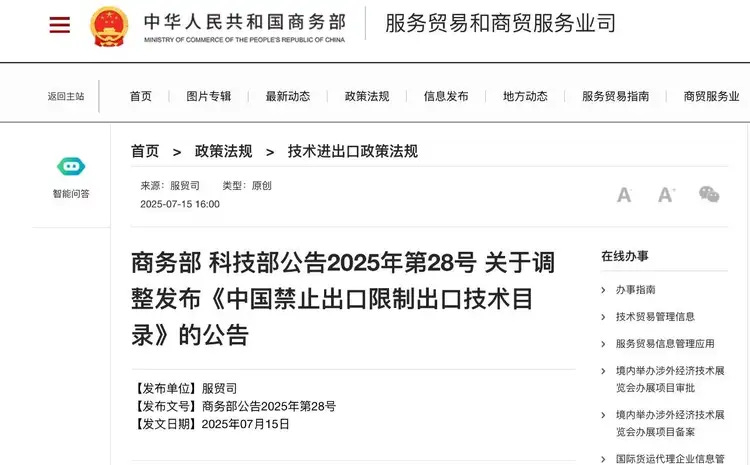MOFCOM Tightens Export Controls on Gallium Extraction and Battery Cathode Material Technologies
Today, China’s MOFCOM officially announced the completion of the public consultation process regarding the export control of gallium extraction technologies and equipment for the preparation of battery cathode materials. The Ministry has now begun to formally implement export restrictions on the relevant technologies and equipment.
A spokesperson for MOFCOM provided detailed information on the background, scope, and rationale of the new measures.
On January 2, China’s MOFCOM amended the “Catalogue of Technologies Prohibited or Restricted from Export in China”(《中国禁止出口限制出口技术目录》) and publicly solicited comments. This revision removed export bans or restrictions involving “traditional Chinese architectural techniques” and added export controls on certain cathode material production technologies for power batteries, lithium extraction technologies, and gallium extraction technologies. More background is available.
Spokesperson of the Ministry of Commerce Answers Reporter Questions on the Revision of the “Catalogue of Technologies Prohibited and Restricted from Export from China”
On July 15, the Ministry of Commerce, together with the Ministry of Science and Technology, released a revised version of the Catalogue of Technologies Prohibited and Restricted from Export from China (MOFCOM & MOST Announcement No. 28 [2025], hereinafter referred to as the “Catalogue”). A spokesperson from the Ministry of Commerce answered reporters’ questions regarding the revision.
1. What is the background and main rationale behind this revision of the Catalogue?
In accordance with the Foreign Trade Law of the People's Republic of China and the Regulations on the Administration of Technology Import and Export of the People's Republic of China (hereinafter referred to as the “Regulations”), the Ministry of Commerce, together with the Ministry of Science and Technology, formulates, revises, and publishes the catalogue of technologies prohibited and restricted from export. Technologies listed as prohibited in the Catalogue shall not be exported, while those listed as restricted are subject to licensing administration. Technologies not listed in the Catalogue are considered freely exportable and are subject to contract registration management.
The Catalogue was initially issued by MOFCOM and MOST in 2001 and has since been partially revised in 2008, 2020, and 2023. This round of revisions reflects the evolving landscape of China’s technological development and is a concrete measure to enhance the governance of technology trade. It aims to safeguard national economic security and development interests while promoting international economic and technological cooperation.
China remains committed to a high level of openness to the outside world. The country continues to facilitate the orderly cross-border flow of innovation factors such as technology, actively integrates into global innovation networks, and consistently improves its domestic business environment. China is willing to strengthen technological exchange and cooperation with other countries, share the benefits of technological advancement, and make positive contributions to global economic stability and human well-being.
2. What are the main adjustments made in this revision of the Catalogue?
During this revision process, broad feedback was solicited from relevant departments, industry associations, experts, scholars, and the public. The key adjustments include the removal of three technology items, the addition of one new item, and the modification of one existing item, as follows:
First, one prohibited item (traditional Chinese architectural techniques) and two restricted items (technologies for building environmental control, etc.) have been removed to promote global sharing of China’s achievements in architectural technologies.
Second, a new restricted technology item has been added: battery cathode material preparation technologies, including three control points — preparation technologies for lithium iron phosphate, lithium manganese iron phosphate for batteries, and phosphate-based cathode raw material technologies. Given the increasing use of such technologies in sensitive sectors, including them in the restricted list will help balance development and security, ensuring their safe and sustainable use.
Third, one existing restricted item, non-ferrous metal smelting technology, has been modified. Five new control points have been added: lithium extraction technologies from spodumene for lithium carbonate and lithium hydroxide production; preparation technologies for metallic lithium (including alloys) and lithium materials; lithium extraction from brines; and purification technologies for lithium-containing liquids. In addition, the control point for gallium extraction has been updated. These changes reflect recent developments in relevant technologies and aim to update regulatory scope accordingly.
3. How should businesses ensure legal and compliant technology exports? What other considerations are there in technology export administration?
According to the Regulations, technology export refers to the transfer of technology from within China to overseas through trade, investment, or economic and technological cooperation. Technologies listed as prohibited in the Catalogue may not be exported. Technologies listed as restricted require an export license, and may not be exported without one. Technologies not listed in the Catalogue are deemed freely exportable, but must be registered through contract filing.
Businesses must comply with the Regulations, the Administrative Measures on Technologies Prohibited and Restricted from Export, and the Measures for the Registration of Technology Import and Export Contracts, fulfilling relevant procedures for licensing or contract registration.
MOFCOM will continue to optimize management measures, streamline export licensing and contract registration processes, offer more public service tools, and guide enterprises in compliance. In response to evolving technological developments and regulatory needs, the Ministry will continue to work with MOST and other relevant authorities to make dynamic adjustments to the Catalogue.


